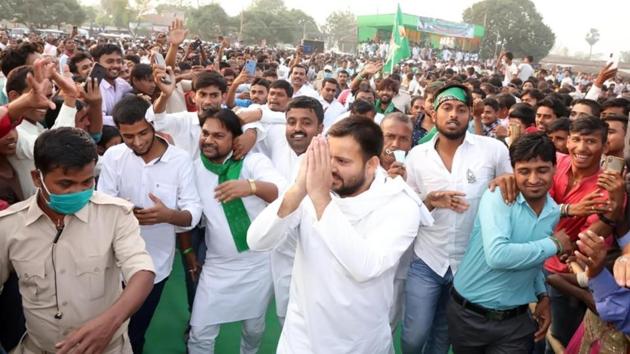Bihar Assembly Election 2020: Grand Alliance poll campaign may have turned election, says survey
If the Mahagathbandhan were to win these elections, the credit should go to Tejashwi Yadav.
If the findings of India Ahead-Lokniti-CSDS the surveys in Bihar are to be believed, the 2020 elections were the National Democratic Alliance’s (NDA) to lose and this is exactly what might have happened. The findings of the post-poll survey, which were released on Monday, have been shared with HT by India Ahead

The NDA started the campaign with a six percentage point lead over the Opposition Grand Alliance or Mahagathbandhan (MGB), according to the Lokniti pre-poll survey which was conducted during October 10-17. The NDA comprises the Janata Dal (United), Bharatiya Janata Party (BJP) and two smaller parties, namely; the Hindustan Awami Morcha-Secular (HAM-S) and the Vikassheel Insaan Party (VIP). The MGB has Rashtriya Janata Dal (RJD), Congress and the three left parties.
As elections progressed – they were held in three phases on October 28, November 3 and November 7 – this lead turned into a three percentage point deficit vis-à-vis the MGB, shows the post-poll survey which was conducted from October 29 to November 9. This three percentage point difference in vote share could lead to a huge difference in seats for the two alliances. The survey expects the MGB to end up with 131-139 assembly constituencies (ACs), while NDA is expected to get 92-100 ACs. The halfway mark in Bihar assembly is 122.
It needs to be underlined that these are survey findings are not the final results. Also, even if surveys get vote shares right, vote share to seat share conversions in a first-past-the-post system can often be treacherous.
If the MGB were to win these elections, the credit should go to Tejashwi Yadav. As someone who only contested his first election in 2015 and ended up becoming the deputy to Nitish Kumar; who is seeking a fourth consecutive term as chief minister, Tejashwi gained a massive 13 percentage point in popularity as the desired CM to beat Nitish Kumar by four percentage points. The latter was four percentage points ahead of Tejashwi in the pre-poll survey. Almost three-fourth of the voters, 73% to be precise, made up their mind during the course of the campaign, and the MGB had a four percentage point lead over the NDA among them.
That the MGB did a better job of persuading the undecided voter is obvious from the fact that it performed much better in attracting voters who did not vote on the basis of party loyalty. While the division of voters who voted on the basis of party is 44% to 42% in NDA’s favour, the MGB had a clear edge vis-à-vis the NDA among voters who voted on the basis of candidates (34%-23%) and other factors (35%-26%).
The survey was shows that both the JD(U) and BJP paid heavily for local anti-incumbency. In ACs where the JD(U) or the BJP had a sitting MLA, 42% and 39% of the voters expressed strong dissatisfaction with them. These numbers were much lower for the RJD (31%) and the Congress (20%).
The MGB also seems to have done significantly better in getting each other’s supporters to vote for the candidates of the alliance. 80% and 89% of traditional Congress and RJD supporters reported voting for the MGB in the post-poll survey. These numbers were 47% and 83% in the pre-poll survey. The synergy within the NDA deteriorated during the course of the campaign. 66% of traditional BJP voters had said that they would vote for the JD(U) during the pre-poll survey. This number dropped to 53% in the post-poll survey. This also suggests that many BJP supporters might have voted for the Lok Janshakti Party (LJP), which had mostly fielded candidates against the JD(U). The LJP is likely to end up with a 7% vote share and 4-8 ACs.
A lot of the commentary on these elections has pointed out the elections were fought on the issues of class and development rather than caste. The survey shows that class complemented rather than substituted caste. The MGB, through its promise of giving a million government jobs, was able to exploit both caste and class in its favour.
While employment (23%) was the second most important issue for the voters after development (36%), the MGB had a massive 32 percentage point lead over the NDA among those who though unemployment was the most important issue. This lead was just one percentage point in the pre-poll survey. The massive tail wind from the jobs promise allowed the MGB to overcome the headwinds from jungle raj barbs of the NDA. The MGB had a 27 percentage point deficit vis-à-vis the NDA among voters who thought development was the most important issue in the pre-poll survey. This came down to 14 percentage points in the post-poll survey.
The survey also shows that the MGB’s success is rooted into a massive consolidation of its traditional Muslim-Yadav support base and small but not insignificant gains among other subaltern communities such as Dalits and Non-Yadav OBCs. The MGB had the smallest support among upper castes. However, it needs to be underlined that the MGB increased its support among all sections during the course of the campaign.




